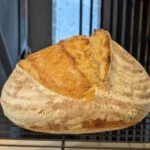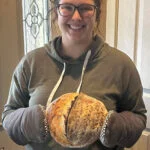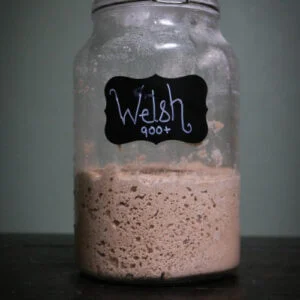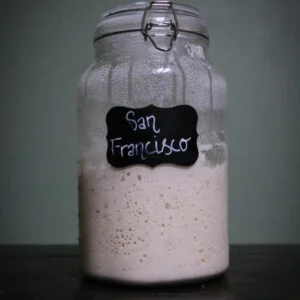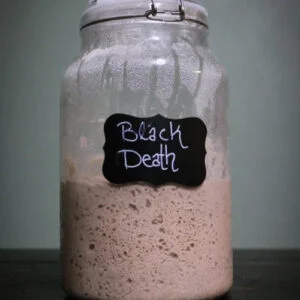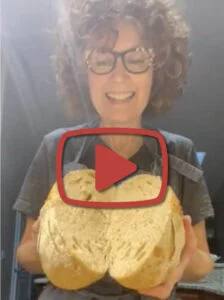Nottingham Farm – Dallas – Oregon – USA
Welsh 900 Year Old Sourdough Starter

Thank you
Thank you so much for supporting our family farm. We hope you enjoy our sourdough starters. Our goal is to find the best, and rarest, sourdough starters and then share the joy of sourdough with you. Below you’ll find “10 Days To Becoming A Sourdough Master” we hope this will be a good starting point for your sourdough journey.
The Flour To Use For The Welsh 900
The Welsh 900 starter requires
Unbleached Stone Ground Whole Wheat Flour
For all feedings
10 Days To Becoming a Sourdough Master
Sourdough is exciting but it can be daunting and we’d like to help you through some of the first steps. We’ve created an example first 10 days for you to take step by step. With something small to learn each day.
First Steps - Getting that Starter Started!
Live Starter - See this Video
Freeze Dried Starter Instructions (Only For Freeze Dried Starter)
1: measure 15 g out and reseal the package. Store the package in a dark cool place
2: Add 25 g of warm water to the 15 g of dried starter. Let it dissolve until you can stir it.
3: add 40 g of unbleached stone ground whole wheat flour and 40 g of warm water to your starter. Put a loose lid on.
4: In 24 hrs, discard (throw some away) until you have 20 g left of starter. Feed your starter with 20 g of flour and 20 g of warm water and mix. Replace lid.
5: Repeat step 4 every day until your starter doubles and becomes active.
*once it has doubled and becomes bubbly, it is ready to use. If it is left on the counter once it becomes active, feed it every 24 hours. If you don’t want to bake every day, you can refrigerate and feed when you’re ready to bake with it.
First Steps In Bread Making- Autolysing Terminology
Today we will be feeding our sourdough again and seeing if it doubles in size and learning some terminology. If you want to keep the starter in a smaller jar you can discard (throw away) half of it and then add 50 grams of UNBLEACHED STONE GROUND WHOLE WHEAT for the feeding process.
Sourdough terminology:
Before we get to the exciting baking, in a couple of days' time, we need to understand what people are telling us. The sourdough world can seem confusing and we want to make it easy. Today we will talk about autolysing.
First Steps In Bread Making- Stretch And Folds
Today we will be feeding our sourdough again and seeing if it doubles in size within 6 hours and learning some new techniques.
If you want to keep the starter in a smaller jar you can discard (throw away) half of it and then add 50 grams of UNBLEACHED STONE GROUND WHOLE WHEAT for the feeding process.
If it does double in size in six hours then your starter is ready to start baking
Gluten Building
"Stretch and Folds" are an important part of sourdough baking. It helps build the gluten and allows shaping of the dough. Today we are going to learn 5 ways to build that gluten.
First Recipe - Waffles!!!
Day 4: Don't forget to feed your starter again today and see if it is doubling in size.
Why don't we use some of that discarded sourdough starter and make the kids happy at the same time?
Today we will use that discarded starter to make something yummy. Learn how to make sourdough waffles better than store bought.
What Is Cold Fermentation? - Sourdough Baking Terminology
Sometimes in a recipe, you'll see the words, cold retard, cold ferment or simply place your dough in the refrigerator for x time. Today's lesson is to learn what this means and to do that we have a quick 2-minute video explaining what this means, why it is done and what the benefits are.
Don't forget to feed your Sourdough again and see if it doubles in size in 6 hours. When it does it will be ready to go for bread baking. It can reactivate in one day or 10 days so don't worry about it just yet.
Check Out The Cook Book
Today we are going to familiarise ourselves with some of the recipes we may be using over the next few days. This is to get a feel for the terminology and to decide what recipes you may want to try. Click the cookbook below to read through the different recipes.
Don't forget to feed your starter today and throw away (discard) any excess if it is getting too big for your jar. You can also use this "discard" to create waffles like the recipe above so it does not go to waste.
The Science Of Sourdough Baking
Well, it's time to get your nerd hat on. Understanding the science behind sourdough baking can give you an overall picture of what is happening and help us understand what we need to do and change to make changes in our loaves.
But don't worry it is only 5 minutes long and an easy listen.
Come Back Every Day For Yor First 10 Days – A New Day Every Day
Sourdough Bible
Baking FAQ's
- Step-By-Step basic process to baking with sourdough
- What is autolysing in sourdough baking
- Can I freeze my bread?
- What is a Dutch Oven
- What is open and closed baking?
- What is the difference between proofing and fermentation?
- The four methods of building tension in your dough.
- Why do I need to build gluten?
- What does salt do to my dough?
- What is a levain and why would I use it?
Starter FAQ's
- Welsh 900 sourdough starter: Maintenance Instructions
- San Francisco Sourdough Starter: Maintenance Instructions
- Black Death Sourdough Starter: Maintenance Instructions
- can I use a metal container?
- Can a starter really last forever?
- What type of lid should I use for my starter?
- Do I Need A Scale?
- Do I Need To Keep Buying Starter
- Are plastic containers bad?
- How Can You Tell The Age Of A Starter?
Sourdough Recipes
- Basic Sourdough Bread Recipe – Welsh 900 Starter
- Basic Artisan loaf – San Francisco 200
- Basic Artisan bread loaf – Black Death 400
- Dinner Rolls – Welsh 900 (Same Day)
- Dinner Rolls – San Francisco 200 (Same Day)
- Dinner Rolls – Black Death 400 (Same Day)
- Lemon Cinnamon Roll Loaf – Welsh 900
- Lemon Cinnamon Roll Loaf – San Francisco
Sourdough Starters
-
 $14.99
$14.99Nottingham Farm has the Welsh sourdough starter. It is said to be passed down th...
-
 $14.99
$14.99San Francisco 200+ Live Sourdough Starter with the distinctive San Francisco ...
-
 $14.99
$14.99Nottingham Farm has The Black Death sourdough starter. It is said to be passe...
-
 $34.99
$34.99Variety Pack - Get any 3 starters Live or dried - At a great price (Now includes...
Sourdough History And Our Family

Gwenllian
Alicia
has always been fascinated by her heritage. One of her ancestors was a Welsh Princess known as Gwenllian the Warrior Princess (Gwenllian Ferch Gruffydd). Contrary to the custom at the time, her father taught her how to fight using swords due to the Norman invasion.
At 13 she met and fell in love with the older Gruffydd ap Rhys, Prince of Deheubarth.
They eloped in secret and later became King and Queen.
Her husband the king and her elder children fought against the Norman invasion and became a scourge to the Norman invaders. The scourge of the Gwenllian family started to hurt the Normans badly so when they found out that the men had gone from the castle on a raiding party and only Gwenllian and her children were there, they surrounded the castle.
Gwenllian knew she had few options, but she escaped to the villages and called them to action against the invaders with the famous Welsh speech:
“Men of Deheubarth, will you join me in battle? I am the daughter of a king, but you are the sons of Wales. This is your land, and the Normans have already stolen much of our birthright. Shall we let them steal even more?”
The speech worked and she raised 200 ill-equipped normal citizens to fight for their freedom. And they were very effective in using what would later become the Guerrilla tactics. They struck hard and fast in small groups against the Normans and disappeared into the night.
They also stopped them from landing supplies to keep their army fed and effective. It was working and she even brought in a fellow chieftain (Maurice de Londres) to help swell the ranks.
This, unfortunately, was her downfall. Maurice betrayed her to the Normans; they found her and were able to strike devastating blows to the citizen army. Gwenllian was felled from her horse and her elder son rushed to her aid only to be killed in front of her.
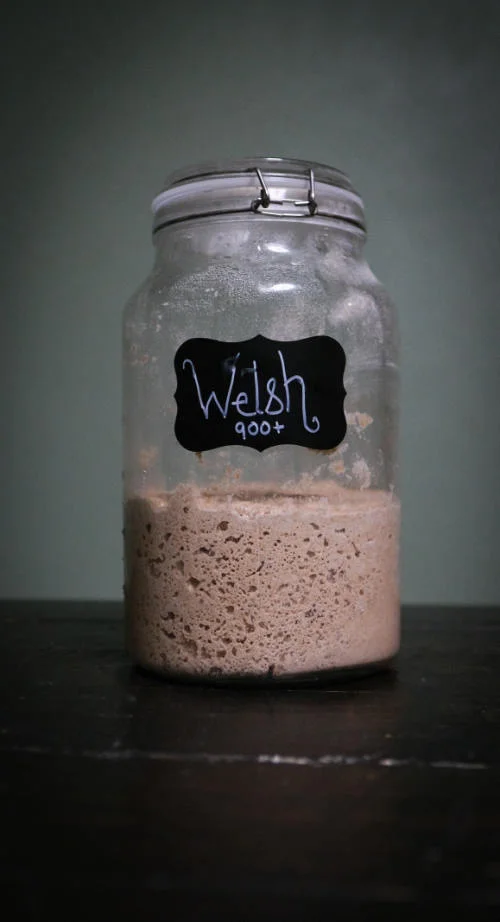
The captured, heartbroken Gwenllian should have expected the common courtesy at the time of being somewhat protected as a woman on the battlefield. Women of the time caught in battle were treated well out of respect and either given a house arrest or traded for prisoner release later on.
But this is where Gwenllian’s military tactics let her down. She was such a good commander that she was not given the courtesy of a captured woman but treated worse than a captured male leader. They wanted rid of the scourge and beheaded her right on the battlefield and for centuries after, Welsh fighters would go into battle with the war cry “revenge for Gwenellian.”
Even though this was over 800 years ago the Welsh sourdough starter was already over 100 years old. It had been started by a Knight, Sir Thomas Clark who is a direct ancestor to Alicia and in fact, the name has been passed down many times with over 26 people in Alicia’s family tree having the name of Thomas Clark. When Alicia started sourdough making and realized her heritage, she felt it was only right to acquire the sourdough of her ancestors and return it to this side of the family. Since then, she has been one of the biggest proponents of the Welsh 900 starter, which is said to be traced back to, at least, Knight, Sir Thomas Clark.
Gwenllian and her husband fought against any of the potential colonisers of the time which ranged between Norman, English and Flemish. They would harass and rob them and then redistribute the wealth to the Welsh under their governorship. In fact, the historian Philip Warner calls the pair the “Robin Hoods of Wales.”
Paul
Ironically Paul was living in the Sherwood Forest boundaries in Nottinghamshire England, the home of the original Robin Hood when he and Alicia met online. Paul was widowed, Alicia was divorced and a whirlwind romance followed. To avoid complications, they secretly eloped (I guess the apple doesn’t fall far from the Gwenllian tree) and were married after knowing each other online for only 3 months and meeting each other for only 3 weeks.
That’s not a lot of time to search for family history. And they probably should have. Their family trees meet at various points: the Scottish Clan of Lindsey, The Clark family and a couple of other places. In fact, Paul has a cousin called…you guessed it, Thomas Clark.
Nothing too close, but Paul still likes to joke that there is nothing more American than getting married in secret to your cousin. Paul grew up in Nottingham England, but has lived in a few countries including, Ireland, Spain, and 5 years in Wales. In fact, he won a half marathon outside Carmarthen castle (An ancestral castle of Gwenllian). And right there in Wales our oldest son Tighe was born.
Tighe
Is the only true Welshman in the family and he is like most of the Welsh, fiercely proud of his Welsh heritage. He was born in the Rhondda Valleys of south Wales and spent much time in the hills and beaches of the area. It also coincides nicely with his American high school team “The Dragons” as the Welsh flag is a dragon. The whole family now lives in Dallas, Oregon but we do have a truly international mix, but still all linked to the Welsh Valleys and Germany.
Germany????
That’s right! Both sides of the family have branches in Germany. Paul through the Haupt line and Alicia through the Schneider line, and that is why they tracked down the German Black Death Starter. The German Black Death oral history puts its creation in southern Germany around the time the Black Death (1633) was ravaging the world. That time period, plus, the dark coloring of the loaves lent itself to the naming of the starter.
San Francisco
We have no history with the San Francisco starter except we like it and it creates great light loaves. Being a younger starter it is easier to trace a line that goes back to or near its creation – said to be traced back to 1810 at a bakery in California. We include it in our line-up as it’s a good all-round starter.
First Loaves
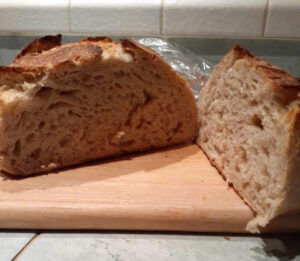
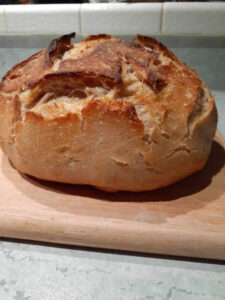

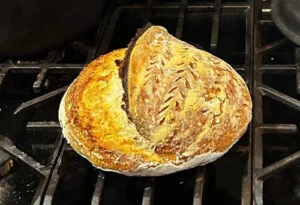
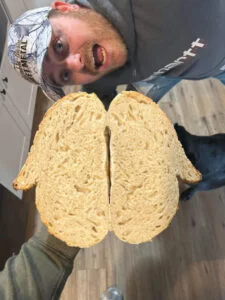
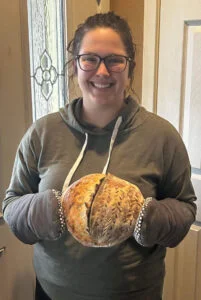
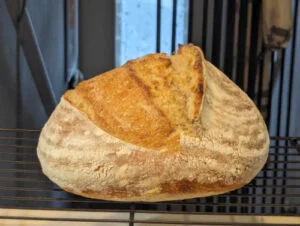
Stay In Contact
We are always planting and busy on the farm. For the quickest response text us on 971-701-7628


